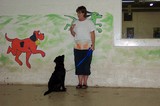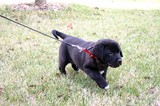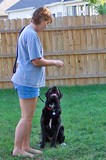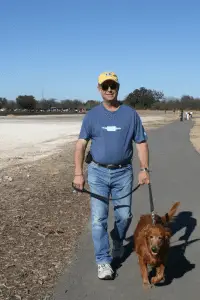Initially, my dogs were as confused by “Heel” as I was.
The fact is, I just hadn’t been teaching them very well.
Here’s how I eventually incorporated some things I learned from loose leash walking and added my own modifications in order to get my dogs to understand the concept of “Heel.”
Finally… dog walks are enjoyable again!
Some Background Info…
My dogs have been through “puppy school”…

And, they’ve also been walked on leashes regularly since they were puppies…

However, each of them STILL seemed to be having difficulty mastering the “Heel” position when we were out on walks.

They would repeatedly try to walk ahead of me, which caused a series of forceful tugs on the leash and meaningless “heel” commands that seemed to confuse the dogs as much as me.
“Heel” to my dogs meant something like this:
She yells “Heel”. I feel a tug on my collar. I slow down a bit. Then I start walking faster again to try to get her to keep up with me. Suddenly I feel the tug on my collar again, which is about the same time she yells “Heel!” again, so I slow down a bit, but she seems to have trouble keeping up with my pace. Geesh… When’s she gonna master this “Heel” command already?
I certainly wasn’t teaching them how to heel very well.
Then I learned about the loose leash walking method. So I took a few pointers from that, added some of my own modifications, and practiced regularly. And now I think that our dogs can finally grasp the concept of “Heel”.
Here’s what worked for me…
First and foremost:
WITH EYE CONTACT, ALL THINGS ARE POSSIBLE!
The fact of the matter is if you want your dogs to listen to you, then you must first have their FULL attention.
See how I taught my dogs to recognize their name and give me their undivided attention (eye contact) every time I called them.
Then, once you’ve mastered the eye contact, then it’s time to switch things up a bit by adding movement and distractions.
How To Maintain Eye Contact While Moving
 Attach a very long leash to your dog’s collar.
Attach a very long leash to your dog’s collar.
Why? Because a short leash doesn’t give him enough room to “test” his limits and learn which behavior you’re going for. Ultimately, if your dog willingly stays with you on a long leash, then it will be easier to teach him to stay with you willingly on a shorter leash later.
Start by getting your dog’s full attention. With the dog standing (or sitting) on your left side, call his name. When he looks at you, reward immediately with a TREAT. Then, start walking. With each and every step that the dog follows along next to you, TREAT.
Finally, once he’s got this part down, you change your movements to include erratic jumps to the right, left, walk backwards, spring forward. Each and every time he follows you, he gets a rapid succession of TREATS.
THERE IS ABSOLUTELY NO TUGGING ON THE LEASH AT THIS POINT.
If your dog gets over-anxious and moves past you, simply stand still and wait for him to come back to you. Don’t let him pull you and don’t you pull him. Instead, lock your arms and bend your knees; by keeping your weight low like this, he won’t be able to yank you off your feet.
If you’ve lost all control and you find yourself trying to coax the dog back into the training lesson, DON’T call him using his name. Instead use “Hey you”. This way, if he isn’t going to respond, you won’t be teaching him that his name is something he can ignore.
After you get his attention back, move in a variety of different directions, and TREAT him for every single step that he follows your lead and moves with you. The moment he veers off and moves in a direction you didn’t initiate, go into your locked your arms stance and be silent. Chances are, he will look to you for guidance, putting you in control of the situation again.
A Video Example… Of Sorts
Have you seen this video of the dog dancing to the song from “Grease”? Watch the dog’s eye contact and how closely his movements match those of his trainer. That’s something along the lines of what we’re going for here…
How To Maintain Eye Contact With Distractions
Now, it’s time to enter some distractions into the equation.
Have a neighbor or family member walk in. Kick a toy around the yard. Make silly noises as you skip through the backyard. All the while giving a TREAT for every single step that your dog took while ignoring the distraction, staying focused on you, and moving exactly where you moved.
As you move through this bizarre series of motions, TREAT repeatedly without stopping your movement.
DO NOT LURE YOUR DOG WITH YOUR HANDS. SIMPLY USE EYE CONTACT.
You will know that your dog has truly grasped the concept of eye contact when his eyes remain focused on you, despite whatever distraction is thrown his way.
If you move, he WILL follow.




How To Maintain Eye Contact While Walking In Public
Finally, you are ready to test what you and your dog have learned together outside the confines of your home or yard. Attach the long leash to your dog’s collar and begin with eye contact.
At this point, your dog learns how to maintain eye contact without having to actually fixate on your face. Instead, his “senses” will be fixated on you, acting as a gauge and keeping him in line.
Start by backing up to ensure that he is focused on you. Pivot so he is on your left and instantly TREAT. Take a step or two and TREAT. Repeat dozens of times, by moving rapidly in different directions and TREATING each time he follows you.
If the dog goes ahead of you, simply say “Hey you” and turn and walk away from him. He will likely follow. (If not, that’s why you have the long leash. Simply go into your locked your arms stance and be silent. Chances are, he will look to you for guidance, at which point, you start again — with the dog on your left… eye contact established… and you initiating all the movements.)
YOU MUST NEVER LET YOUR DOG PULL YOU WHILE WALKING… EVER!
The Ultimate Goal
 After a week or so of regular walks on a loose leash next to you, your dog will have mastered the true concept of “Heel”.
After a week or so of regular walks on a loose leash next to you, your dog will have mastered the true concept of “Heel”.
Simply move to a short leash from this point forward, and you will have an enjoyable time walking with your dog — with no tugging — on his part or yours!
Plus, you will have the added bonus of knowing that whenever you call your dog’s name, his eyes will focus attentively on you and only you, despite any distractions.
NOTE: From this point forward, whenever your dog is on the leash, that time together should always be considered a one-on-one training session where you are the one dictating all of the moves, turns, and eye contact. Otherwise, if he’s on the leash and sometimes you let him pull, other times you disallow pulling, sometimes you insist on eye contact, and other times you let your dog call the shots, then your dog will never grasp the concept of walking comfortably by your side.
Give The Command A Name
Finally, you need to pick a unique word or phrase that you will used to describe this type of walking with your dog from this point forward.
“Heel” may not be the best word choice, especially if your dog heard it used a lot before he ever grasped the full concept of “Heel”.
Instead, you might try “Walk” or “With Me” or “Easy Walk” you get the idea. (Do not include the word “Come” in your command — such as “Come with me” — because that will dilute the true meaning of the “Come” command.)
When your dog learns to heel, your walks together will be much more enjoyable!
…Here’s to many years of enjoyable walks together!
Video: How To Teach Your Dog To Heel
In the following 4-minute video, dog trainer Dave Melchionno walks you through the steps you need to know to effectively teach your dog to heel:




